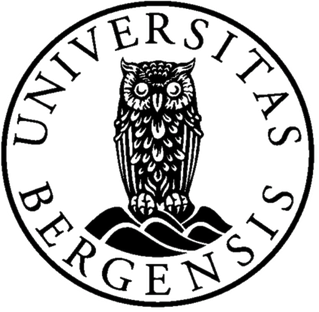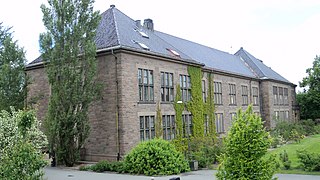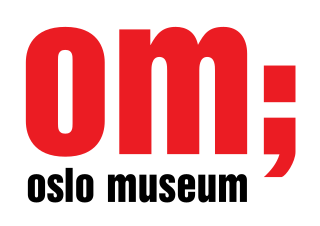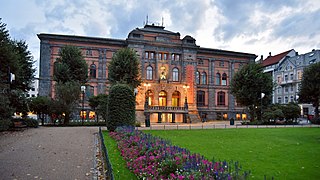


The University Museum of Bergen (Norwegian : Universitetsmuseet i Bergen) is a university museum in Bergen, Norway. The museum features material related to anthropology, archaeology, botany, geology, zoology, art, and cultural history. [1]



The University Museum of Bergen (Norwegian : Universitetsmuseet i Bergen) is a university museum in Bergen, Norway. The museum features material related to anthropology, archaeology, botany, geology, zoology, art, and cultural history. [1]
The University Museum of Bergen was founded in 1825 by Wilhelm Frimann Koren Christie, at the time president of the Storting. Founded under the name University Museum of Bergen with the intent of building large collections in the fields of culture and natural history, it became the grounds for most of the academic activity in the city, a tradition which has prevailed since the museum became part of the University of Bergen. The University Museum of Bergen is divided into two departments, the Natural History Collections and the Cultural History Collections and Public Outreach and exhibitions. It is also the caretaker of the museum garden, formerly the botanical garden, surrounding the natural history building, and the city's arboretum. [2]
This was the first dedicated museum building in Norway. In its early years, the museum contained numerous art collections, including several works by the painter Johan Christian Dahl, cultural artefacts, and craftwork items. [3] In 1831, the museum moved from its location in the Seminarium Fredericianum building near Bergen Cathedral School (Bergen katedralskole), to a new building southwest of Lille Lungegårdsvannet. [4]
The current natural history building was designed by Johan Henrik Nebelong and finished in 1865. Bergen Museum moved in during 1866. The wings of the building were added in 1898 and the botanical garden was laid out between 1897 and 1899. The cultural history department got its own building in 1927. The increasing research activity at the museum from the late 19th century and onward led directly to the founding of the University of Bergen in 1946. [3]

The University of Bergen is a public research university in Bergen, Norway. As of 2021, the university had over 4,000 employees and 19,000 students. It was established by an act of parliament in 1946 consolidating several scientific institutions that dated as far back as 1825. It is Norway's second-oldest university, and is considered to be one of the nation’s four so-called "established universities." It has faculties and programmes in all the academic fields typical of a classical university, as well as such degree programmes as medicine and law that, traditionally, only the “established universities” are authorized by law to offer. It is also one of Norway's leading universities in many of the natural sciences, including marine research and climate research. It has consistently been ranked in the top 200 or top one percent of universities in the world, and as one of the best 10 or best 50 universities worldwide in some fields, such as earth and marine sciences. It is part of the Coimbra Group and of the U5 group of Norway's oldest and highest-ranked universities.

The University of Helsinki is a public university in Helsinki, Finland. The university was founded in Turku in 1640 as the Royal Academy of Åbo under the Swedish Empire, and moved to Helsinki in 1828 under the sponsorship of Tsar Alexander I. The University of Helsinki is the oldest and largest university in Finland with the widest range of disciplines available. In 2022, around 31,000 students were enrolled in the degree programs of the university spread across 11 faculties and 11 research institutes.

The University Botanical Garden is Norway's oldest botanical garden. It was first established in 1814 and is administered by the University of Oslo. It is situated in the neighborhood of Tøyen in Oslo, Norway.

The National Museum is a museum in Oslo, Norway which holds the Norwegian state's public collection of art, architecture, and design objects. The collection totals over 400,000 works, amongst them the first copy of Edvard Munch's The Scream from 1893. The museum is state-owned and managed by the Norwegian Ministry of Culture.

The Natural History Museum Vienna is a large natural history museum located in Vienna, Austria.

Hanseatic Museum and Schøtstuene is a museum in the city of Bergen, Norway.

Johan Christian Claussen Dahl, often known as J. C. Dahl or I. C. Dahl, was a Danish-Norwegian artist who is considered the first great romantic painter in Norway, the founder of the "golden age" of Norwegian painting. He is often described as "the father of Norwegian landscape painting" and is regarded as the first Norwegian painter to reach a level of artistic accomplishment comparable to that attained by the greatest European artists of his day. He was also the first to acquire genuine fame and cultural renown abroad. As one critic has put it, "J.C. Dahl occupies a central position in Norwegian artistic life of the first half of the 19th century.

The University of Copenhagen Botanical Garden, usually referred to simply as Copenhagen Botanical Garden, is a botanical garden located in the centre of Copenhagen, Denmark. It covers an area of 10 hectares and is particularly noted for its extensive complex of historical glasshouses dating from 1874.

The National Museum of Bosnia and Herzegovina is located in central Sarajevo, the capital of Bosnia and Herzegovina.

Gamlehaugen is a Royal Castle in Bergen, Norway, and the residence of the Norwegian royal family in the city. Gamlehaugen has a history that goes as far back as the Middle Ages, and the list of previous owners includes many of the wealthiest men in Bergen. Today owned by the Norwegian state, the most recent private owner was Christian Michelsen, a politician and shipping magnate who later became the first prime minister of Norway after the dissolution of the union between Sweden and Norway. Michelsen commissioned the construction of the current main building at Gamlehaugen, where he would live for most of the rest of his life.

Damsgård Manor is a landmark manor and estate in Bergen, Norway. It is noted for its distinct rococo style and is possibly the best preserved wooden building from 18th-century Europe.

The Finnish Museum of Natural History, established in 1988, is a research institution under the University of Helsinki in Finland, based in Helsinki, Finland. It is a natural history museum responsible for the national botanical, zoological, geological and paleontological collections, which consist of samples from around the world. The collections serve scientific, public informational and educational purposes.

The NTNU University Museum in Trondheim is one of seven Norwegian university museums with natural and cultural history collections and exhibits. The museum has research and administrative responsibility over archaeology and biology in Central Norway. Additionally, the museum operates comprehensive community outreach programs and has exhibits in wooden buildings in Kalvskinnet.

Milde is a neighbourhood in the city of Bergen in Vestland county, Norway.

The Natural History Museum at the University of Oslo is Norway's oldest and largest museum of natural history. It is situated in the neighborhood of Tøyen in Oslo, Norway.

Siljustøl is a museum situated in the borough of Ytrebygda in Bergen, Norway. It was previously the home of composer and musical artist Harald Sæverud and his wife Marie Hvoslef.

Oslo Museum is a museum dedicated to the history and culture of Oslo, Norway. The museum is headquartered at Frogner Manor in Frogner Park, together with two of its departments; Oslo City Museum and Theatre Museum.

The West Norway Museum of Decorative Art, also referred to as KODE 1, is located in Bergen, Norway. It was established in 1887 at the initiative of Johan Bøgh. In 1896 the museum moved into a permanent exhibition building, a Renaissance Revival structure designed by Henry Bucher (1864–1944). The building caught fire during the 1916 Bergen fire but was saved.

Johan Johnsen Havaas (Havås) was a farmer and botanist from Granvin in Hordaland.
60°23′15.44″N5°19′17.69″E / 60.3876222°N 5.3215806°E